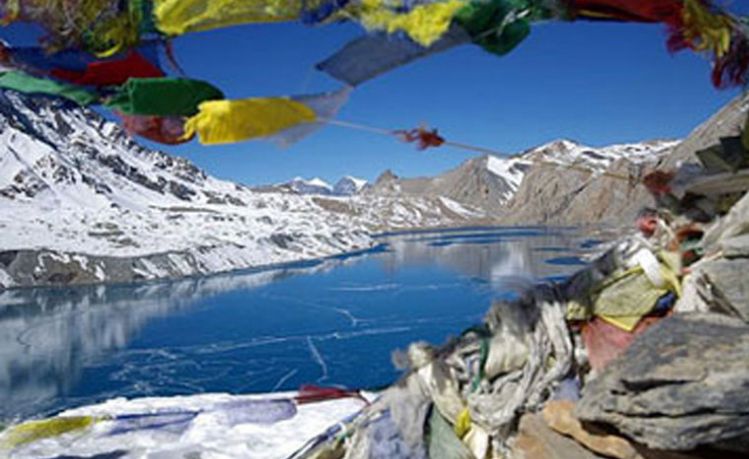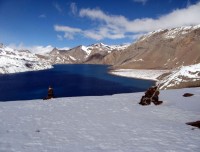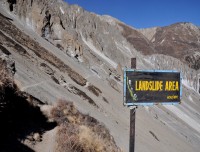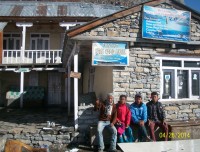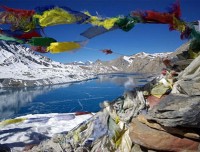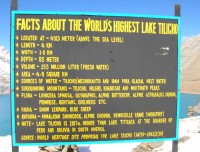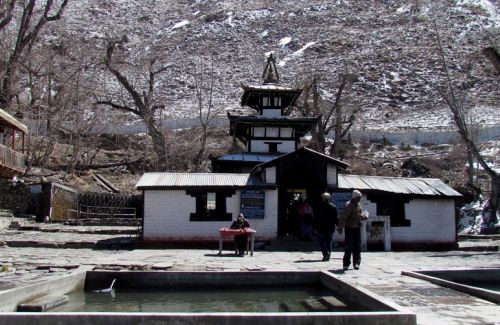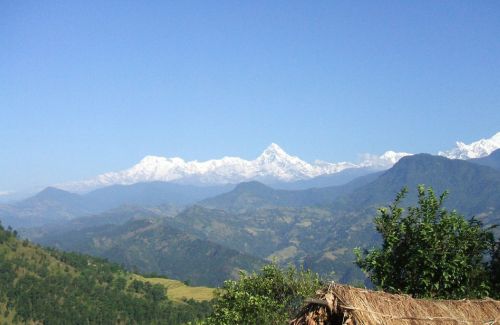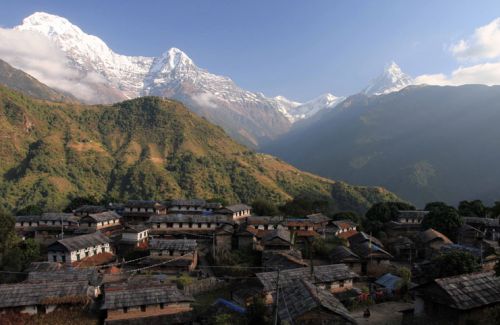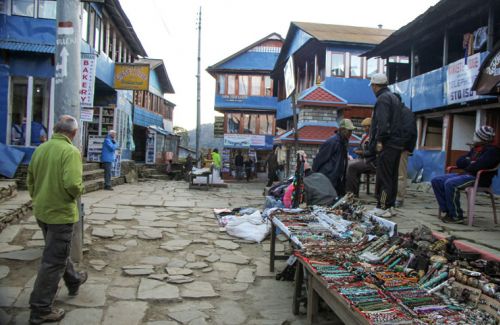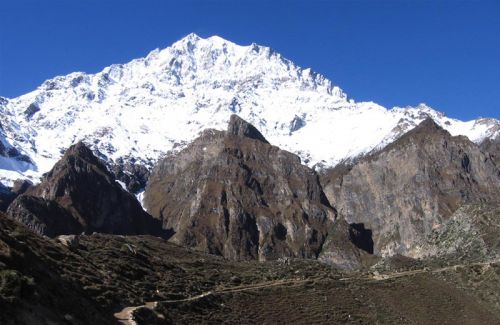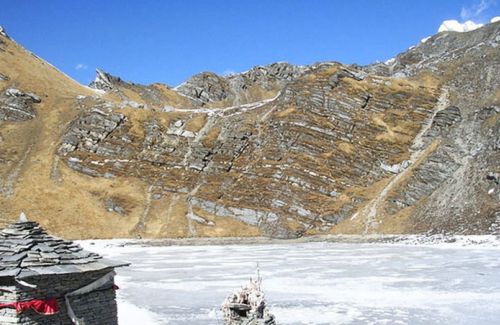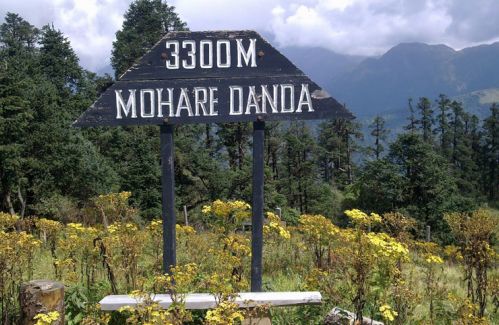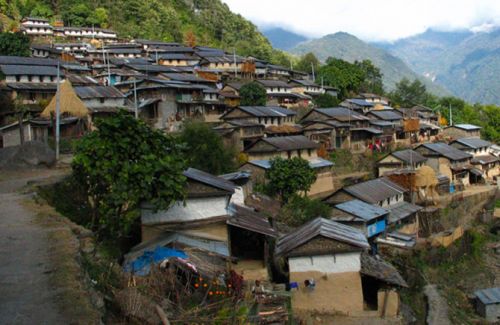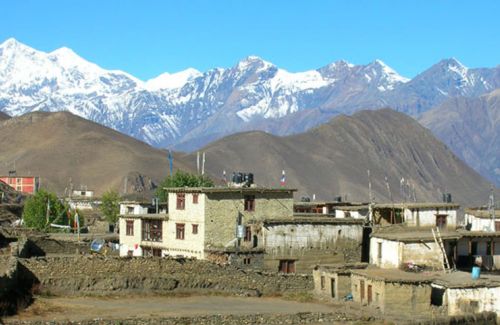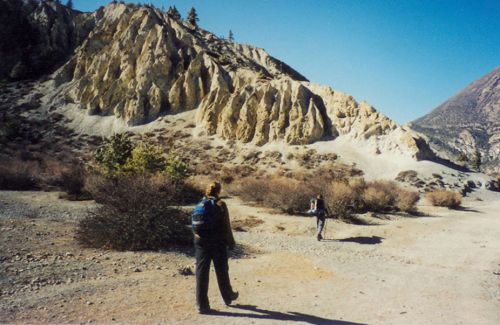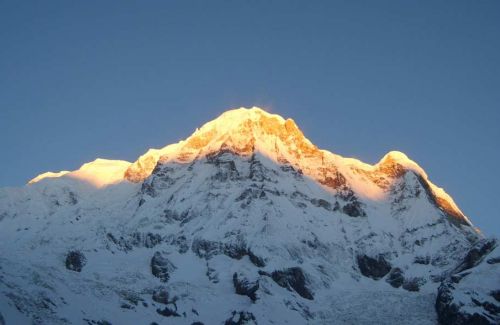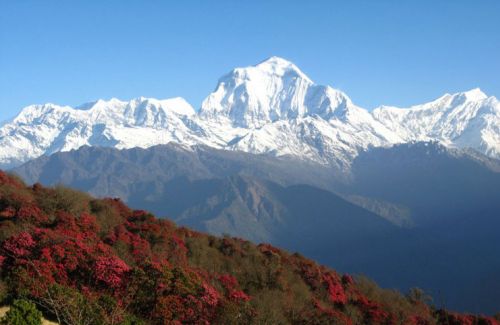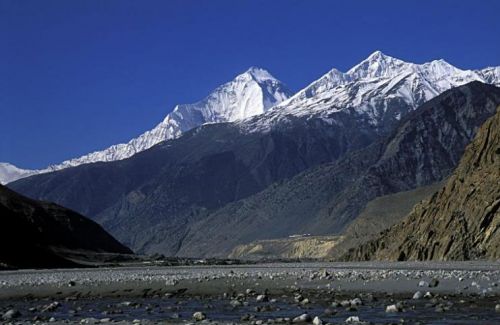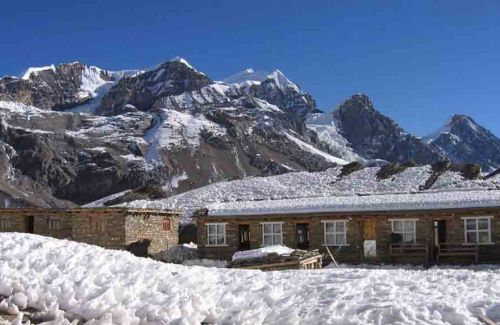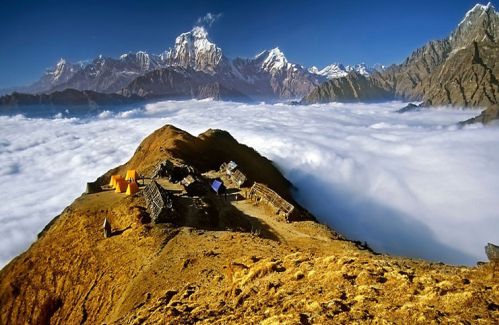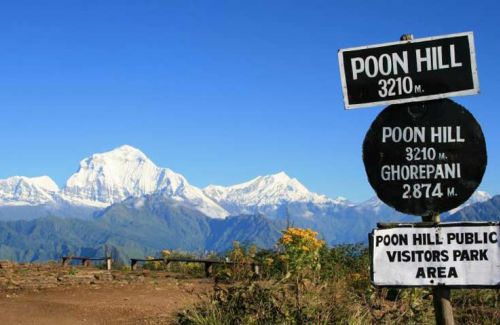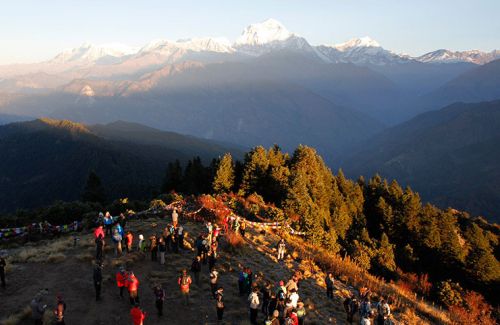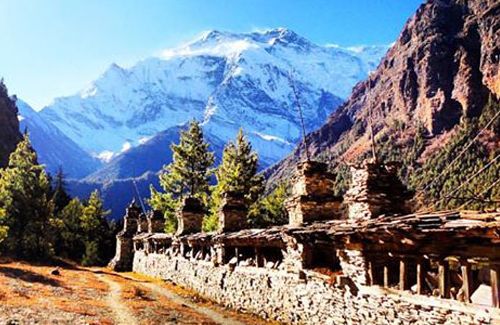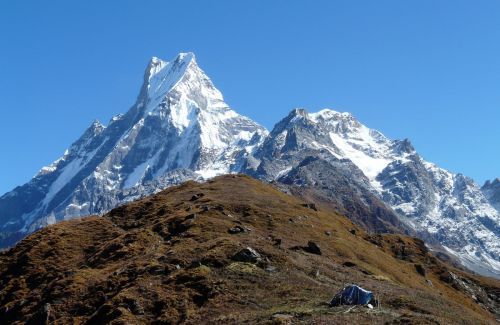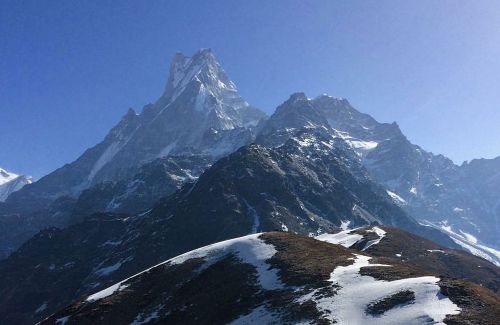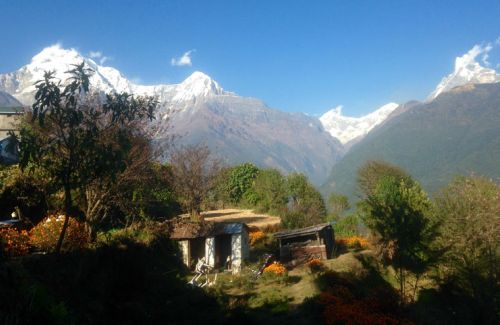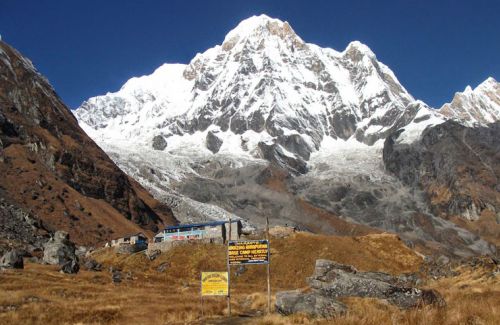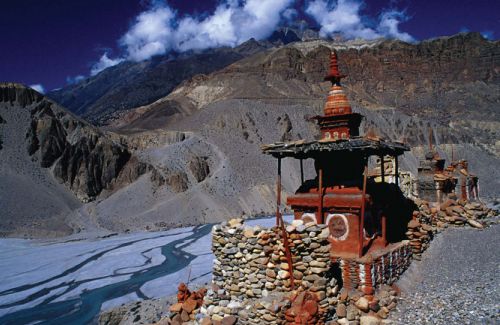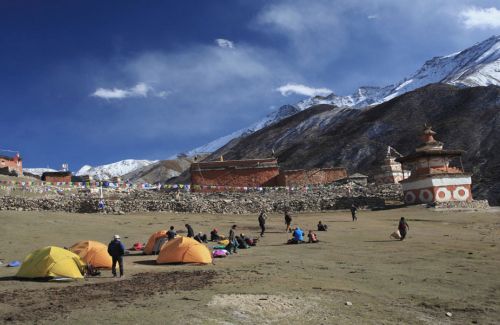Tilicho Lake Trekking
- Duration18 Days
- Max. Altitude5,416 m
- Starts FromUSD 1525
Destination:Nepal
Trip Grade:Strenuous (****)
Meals:Breakfast + Lunch + Dinner
Transportation:Private Vehicle / Aeroplane
Accommodation:Lodge
Season:September to Late December & February to Late June
Show AllTilicho Lake is the lake situated 4,919 m high, high altitude lake in the world. It lies in the Annapurna Range in the Himalayas in Manang District of Nepal. Tilicho Lake Trekking can be done as a side trek from the Annapurna Circuit Trekking route. The final approach to the lake is done in a day hike from the lodge at Tilicho Base Camp.
We drive from Kathmandu to Beshishahar to the west. It is 185 km and takes about 7 hours by bus. We drive from Beshishahar to Syange the next morning after breakfast then begin to walk from Syange to Chamje. We can see the waterfall and arrive at Jagat, situated in the saddle in the forest. Continuing through the broad leaved forest and pass overhang suitable campsite, we cross a small tributary and admire the spectacular waterfalls on the other side of the river. After an hour from Jagat, we reach the small settlement of Chamje. We descend, cross the Marshyangdi Khola, continue upstream and arrive at the Tal (1,707 m).
The trail to Manang crosses the small tributary beyond Taland reach to Dharampani (1,943 m). A pleasant half an hour’s walk brings us around the corner to the town of Bagarchhap (2,164 m). The way following Marshyangdi Khola, we reach to Chame and joining the valley of Braga, we arriva at Pisang. The village of Manang is half an hour beyond Braga. We head up the valley for half an hour to the ridge crest (3,581 m). Finally we reach to Manang. To the west of Manang, there is a Khangsar village, the last habitation before Tilicho Lake. Beyond, we can see the impressive north face of Tilicho Peak. It takes 2 days to reach Tilicho from Khangsar.
To go to Muktinath, we should cross the Thorong La the high pass. We first cross the tributary below the falls beyond Manang and reach Tengi (3,642 m). From Tengi, we come to Phedi via Leder. From Phedi, we ascend to a notch and head left traversing to the base of a prominent lateral moraine. We cross the Thorong La pass and descend to Muktinath. So, the Tilicho Trek gives an amazing trekking experience in life.
Trip Highlights
- Scenic drive from Kathmandu to Beshishahar
- Follow the Marshyangdi River and its stunning natural scenery
- Visit the oldest monastery of Braga
- Be familiar with Buddhist and Bon Culture
- See the spectacular beauty at Manang and their living style
- Reach in the top of Tilicho Lake
- The magnificent view of Annpurna, Manaslu and Dhaulagiri
- Visit the famous Hindu pilgrimage sites- Muktinath
- Feel the hospitality of Thakali people
- Cross the high Thorong La Pass
Day to Day Itinerary
Day 01:Arrival at Kathmandu Airport (1,350 m), then transfer to Hotel. Overnight at Hotel
Day 02:Drive from Kathmandu to Beshishahar by tourist bus (830 m), 7 hrs. O/N at Guest House
Day 03:Drive from Beshishahar to Syange and trek to Chamje (1,400 m), 5 hrs. O/N at Guest House
Day 04:Trek from Chamje to Bagarchhap (2,160 m), 5 hrs. O/N at Guest House
Day 05:Trek from Bagarchhap to Chame (2,630 m), 5 hrs. O/N at Guest House
Day 06:Trek from Chame to Pisang (3,300 m), 5 hrs. O/N at Guest House
Day 07:Trek from Pisang to Manang (3,540 m), 5 hrs. O/N at Guest House
Day 08:Acclimatization day at Manang village. O/N at Guest House
Day 09:Trek from Manang Village to Khangsar Village (3,700 m), 4 hrs. O/N at Guest House
Day 10:Trek from Khangsar Village to Tilicho Base Camp (4,200 m), 5 hrs. O/N at Guest House
Day 11:Trek to Tilicho Lake (5,200 m) and back down to Tilicho Base Camp (4,200m), 6 hrs. O/N at Guest House
Day 12:Trek from Tilicho Base Camp to Yak Kharka (4,000 m), 5 hrs. O/N at Guest House
Day 13:Trek from Yak Kharka to Thorong Phedi (4,450 m) 5 hrs. O/N at Guest House
Day 14:Trek from Thorong Phedi to Muktinath (3,800 m) via Thorung La pass (5,416 m), 8 hrs. O/N at Guest House
Day 15:Trek from Muktinath to Jomsom (2,720 m), 5 hrs. O/N at Guest House
Day 16:Morning flight from Jomsom to Pokhara (827 m), 35 mins. O/N at Hotel
Day 17:Drive back from Pokhara to Kathmandu (1,350 m), 7 hrs.O/N at Hotel
Day 18:Transfer to International airport
Cost Include
- Airport Picks up and Drops off by private tourist vehicle
- Guided city tour in Kathmandu by private tourist vehicle
- 3 nights in Kathmandu and 1 night in Pokhara, twin sharing basis accommodation in 2-3 star hotel with breakfast
- Full board (Breakfast + Lunch + Dinner) meals during the trek
- Guest houses, lodges basis accommodation during the trek
- Drive from Kathmandu to Beshishahar by local bus
- A government licensed holder city tour guide for city tour in kathmandu
- An experienced English speaking Trekking Guide
- The required number of porter to carry your luggage during the trek (2 Trekkers = 1 Porter)
- Food, accommodation, insurance, salary, equipments, transportation for Guide and Porter
- Domestic flight tickets from Jomsom - Pokhara with airport tax
- Annapurna Conservation Area Entry Permit and TIMS Card for the trekking
- Down Jacket, Duffel Bag, Sleeping Bag by Himkala Adventure if required
- Farewell Dinner with Nepalese Cultural Show
- Government taxes, VAT, service charge
Cost Exclude
- Lunch and Dinner in Kathmandu and Pokhara
- Entrance fees for the sightseeing in the heritage sites
- Personal Trekking Equipments
- Nepal Visa fee (visa charge USD 40 and 4 passport photographs for the visa and permit)
- International airfare to and from Kathmandu
- Extra night accommodation in Kathmandu
- Travel Insurance and rescue evacuation
- Personal Expenses like Phone Bill, Hot and Cold drinks etc.
- Tips for trekking staff and driver (Tipping is expected)
- Any others expenses which are not mentioned on 'Cost Includes' section
Detail Itinerary
Day 01Arrival at Kathmandu Airport (1,350 m), then transfer to Hotel. Overnight at HotelUpon your arrival at Tribhuvan International Airport in Kathmandu, our representative from Himkala Adventure will be waiting outside and greets you. After that you will be transferred to the hotel at Thamel, the touristic area. After check in at hotel, you can take rest and walk around Thamel in your spare time. Overnight at Kathmandu
Day 02Drive from Kathmandu to Beshishahar by tourist bus (830 m), 7 hrs. O/N at Guest House After breakfast, we drive from Kathmandu to Beshishahar. This is the scenic drive with the panoramic view of the countryside, terraces, hills, forests and typical Nepali houses. You culd observe the Nepali farmers working in the field following the traditional method of farming. It is about 7 hours drive and we arrive at Beshishahar. Overnight at Guest House
Day 03Drive from Beshishahar to Syange and trek to Chamje (1,400 m), 5 hrs. O/N at Guest House After breakfast, we drive from Beshishahar to Syange. The trail goes to Syange through Bahundanda (The Brahmin Hill). It steeply drops to Syange from Bahundanda. While leaving Bahundanda, we can see the beautiful waterfall. After crossing the suspension bridge over the Marshyangdi River, we follow the river to the village of Jagat before climbing through the forest to Chamje. Overnight at Guest house
Day 04Trek from Chamje to Bagarchhap (2,160 m), 5 hrs. O/N at Guest House After breakfast, we begin our trek with the rocky trail following the Marshyangdi River and go gradually uphill to Tal (1,675 m). We cross the flat valley and the trail goes up and down to Dharapani (1,890 m). We can clearly see the Tibetan influence in the village here. After a while, we reach to Bagarchhap (2,160 m) where we see the flat roofed stone houses surrounded by apple orchards and maize fields. Overnight at Guest house
Day 05Trek from Bagarchhap to Chame (2,630 m), 5 hrs. O/N at Guest House Today, after breakfast, we ascend to Tyanja (2,360 m) and continue through the forest and arrive at Kopar (2,590m). Chame is the headquarters of the Manang District. The great view of Annapurna II hypnotizes us there. The two small hot springs in the town are another attraction there. We will be familiar about the typical Manangis culture similar to the Tibetans. Overnight at Guest house
Day 06Trek from Chame to Pisang (3,300 m), 5 hrs. O/N at Guest House We begin our trek through deep forest after having breakfast and follow the way through narrow valley. We cross the river on a long bridge and again cross another bridge. The view of Paungda Danda, the craggy hill towering high can be seen. Then, the trail goes up ascending to Pisang. Overnight at Guest House
Day 07Trek from Pisang to Manang (3,540 m), 5 hrs. O/N at Guest House The trails contours through the drier part of Upper Manang, no monsoon effect due to the blockage by the Annapurna Massifs, a rain shadow area. People here herd the yaks, produce crops for part of the year and do trade from Tibet. Leaving Pisang, we have alternate trais north and south of the Marshyangdi River which meets to Mungji. The southern route by Hongde with its airstrip (3,325 m) involves less climbing then the northern route via Gheru through the northern bank of the river. From Mungji, the trail continues and arrives at Bryanga (3,475 m) nearby Manang. Overnight at Guest house
Day 08Acclimatization day at Manang village. O/N at Guest House Today is the day to explore Manang and for the acclimatization so that we could be fit for the hike to Tilicho for the next two days. We can walk around the village. If we are lucky, then we can observe the horse race and the archery contest. The magnificent view of the mountains can be seen from there. Overnight at Guest house
Day 09Trek from Manang Village to Khangsar Village (3,700 m), 4 hrs. O/N at Guest House After breakfast, we trek through the western gates and follow the pathdown to the river. After crossing the bridge over the Khangsar Khola, we ascend the slope to the village. The Khangsar village is the outlying village in Nepal. Overnight at Guest house
Day 10Trek from Khangsar Village to Tilicho Base Camp (4,200 m), 5 hrs. O/N at Guest House After breakfast, we continue the trail from Khangsar, pass the Gompa and follow the newly constructed trail towards the high ridge. There is an intersection in one point, we then go through slope and reach at the narrow valley. The other continues to ascend towards the line of the ridge. The first one is the old path which is very difficult and the other on e is the new path. We continue the new path, reach the high crest and descend the slope to a side of the main valley. On the bottom of it is a brook and the other side of the building is the Tilicho Base Camp. Overnight at Guest house
Day 11Trek to Tilicho Lake (5,200 m) and back down to Tilicho Base Camp (4,200m), 6 hrs. O/N at Guest House We hike early in the morning trying to avoid the wind. It takes about 3-4 hours from Tilicho Base Camp to the Tilicho Lake. This is the Lake situated in the high altitude (5,200 m) in the world. Hindus take it as the sacred lake and as a pilgrimage tour flocked here in 2001. There is no human settlement so we just walk around the lake and retrace back to Tilicho Base Camp. Overnight at Guest house
Day 12Trek from Tilicho Base Camp to Yak Kharka (4,000 m), 5 hrs. O/N at Guest House After breakfast, we descend from Tilicho Base Camp to Khangsar village passing through the ruins of Old Khangsar. We continue the trail that goes down to the river. We cross an old log bridge between Gumsang and Yak Kharka and finally arrive at Yak Kharka. Overnight at Guest house
Day 13Trek from Yak Kharka to Thorong Phedi (4,450 m) 5 hrs. O/N at Guest House After having breakfast at Yak Kharka, we climb about 2 and half hours and descend to the river. After we cross the river at an elevation of 4,450 m, we again climb up to Thorong Phedi at 4,450 m. There we find newly built guest houses. Overnight at Guest house
Day 14Trek from Thorong Phedi to Muktinath (3,800 m) via Thorung La pass (5,416 m), 8 hrs. O/N at Guest House Today is the challenging day because we have to cross the difficult pass – Thorong La. It is the long day walk starts before sunrise at 4 am. It takes about 5-6 hours to reach the pass. The afternoon becomes windy so we start to climb steeply targeting to reach at an altitude of 5,416 m. There are two things caused the problems to cross the pass – the snow and the altitude. After the 4 hours continuous walk, we can see the spot marked by chortens and the prayer flags. As we reach the top, we will be overwhelmed by the astonishing beauty from the top. After the succinct view of mountains and the landscape, we trek down to Muktinath which takes another 4 hours. Muktinath, known as the sacred pilgrimage site for duo Hindus and Buddhists. Overnight at Guest house
Day 15Trek from Muktinath to Jomsom (2,720 m), 5 hrs. O/N at Guest House Today, after breakfast, we follow the trail down to Ekali Bhatti. Then it continues following the KaliGandaki River to Jomsom. Jomsom is the headquarters of Mustang District. Overnight at Guest house
Day 16Morning flight from Jomsom to Pokhara (827 m), 35 mins. O/N at Hotel We fly in the morning from Jomsom to Pokhara. It takes about 35 minutes. After we land at Pokhara Airport, we drive to the hotel at Pokhara. In the day time, after Lunch, we go for city sightseeing to Davi’s fall, Gupteshwor cave; Tibetan Refugees camp and go for an hour boating at Phewa Lake. Overnight at hotel
Day 17Drive back from Pokhara to Kathmandu (1,350 m), 7 hrs.O/N at Hotel After breakfast, we drive back to Kathmandu on the Prithivi Highway which is 200 km from Pokhara to Kathmandu. It takes about 7-8 hours by bus. The journey is smooth and full of natural scenery. We can have lunch on the way. After arrival in Kathmandu, we transfer to the hotel. There will be dinner together with Nepalese Cultural Show. Overnight at hotel
Day 18Transfer to International airport We transfer you to the Tribhuvan International Airport 3 hours before to your scheduled flight. If you have enough time left, you could go for shopping in the local market and buy some dainty gifts from Nepal to your family members and friends. Finally, with gratitude from Himkala Adventure that you joined us for the trek to Tilicho Lake, we depart from the airport. We wish you for your safe journey to the next destination. Namaste!!!
Trip FAQ
Himkala Adventure would like to quench the thirst of all necessary questions answers about Tilicho Lake Trekking for all curious travelers/trekkers in the world. As you are entirely from different geographical location, you could better to know everything about the treks from the beginning i.e. airport pick up till your departure like airport picks up, drops off, accommodation in city, in the trek, guide and porters, safety for the trekking, food and accommodation and some other things that you might face on the way. Hope our endeavor listing these questions answers will help you self informed.
This is simply the outlines of the services we offer but it may differ as per your requirement, number of trekkers. What we go through our conversation, we will manage the means of transportation, hotels in the city, accommodation in the trekking, numbers of porters etc. This is general idea about Tilicho Lake trekking before your trip and you become clearer about the trek. Please feel free to contact us to get more information about the trekking in the Himalayas of Nepal.
1) How is Tilicho LakeTrekking in Nepal?
Tilicho Lake Trekking is an amazingly fascinating trekking to the Tilicho Lake (5200 m), the highest altitude lake in the world.The trek reaches 5416 m and crosses the Thorung La pass. It is the strenous trek which offers the glacial view of entire northern slopes of Annapurna and Thorang Peak. In 2001, Hindu pilgrims from around the world flocked to the lake believed that it is a holy spot mentioned in the Ramayan - a holy book of the Hindus.
2) What physical fitness do I need to book this trip?
Every trekking in the Himalayas of Nepal require the certain level of physical and mental fitness.So, we advise you to be in good physical shape and able to feel comfortable while hiking up and down 7 to 12 miles per day on a trail carrying a day pack of about 10 pounds. Three things could make you confident enough for any trek you would like to do: aerobic, strength and mental.
Aerobic conditioning is important primarily because you will be trekking in thinner air, up to 40% less than at sea level. With good aerobic conditioning, you will be able to better metabolize whatever oxygen is available to you. You should plan on doing at least one hour of aerobic 3 /4 times per week for 1 month or more before your arrival in Nepal. Walking, jogging, cycling, hiking on valley floor to ridge line ascents with day back are some of the excellent forms of exercise, so long as you are strengthening leg muscles and building stamina. Speed is not the essence; stamina, confidence and continuity are.
3) How do I find Himkala Adventure for my pick up at the airport?
Our representative from Himkala Adventure will display a small board of company or your name on the sheet of paper outside the airport terminal. You will be driven to the hotel by our tourist vehicle.
4) What sort of accommodation do I get in Kathmandu and Pokhara?
Normally we provide standard rooms with twin sharing accommodations at three star or similar category hotels in Kathmandu and Pokhara including breakfast. Accommodation in these cities can be upgraded as per your request. But some of our packages are sold without accommodation in the city.
5) How are tea house facilities during Tilicho Lake Trekking?
Tea House is the combination of guest house, restaurant, and social hang out. Tea houses in Tilicho Lake Trekking area are highly professional though they are simple but with neat and clean lodging offering fine views and plain but fresh and hygienic food with friendly atmosphere Most of the Tea Houses have running water facility. Many of them have hot water available for bathing. But we discourage our groups from using water heated by wood as lack of firewood in most villages is a big environmental concern in Nepal.
6) What sort of accommodation do I get in trekking?
Guesthouses/Tea Houses/Lodges provide twin sharing single and double rooms and occasionally a dormitory which is basically clean with a mattress and a quilt or blanket. Our company provides the sleeping bag if needed but we always recommend having your own sleeping equipments. You have to share the room with your group member or sometimes with unknown traveler. The toilet is always outside the room with basic facilities.
7) What sort of foods, water and drinks can I expect in trekking?
The foods in the Himalayas are very simple. There are mostly the family members themselves to cook and serve the meal. They are simply trained but experienced because they have been offering such services for many years in this busy route. The food is hygienic, fresh and delicious. We recommend you to drink mineral water or the boiled or using water purification pills or drops.
Most of the foods are cooked in the kitchen of tea houses. They serve you with different varieties of delicious Nepali and continental dishes. The most popular Nepali food is daal bhat (rice and lentils) with some mixed vegetable curry. Garlic soup is popular as it helps you with acclimatization. You could better be vegetarian in the mountains. All hotels in cities and guesthouses in trekking serve the vegetarian food. You can find all common types of drinks like hot chocolates, coffee, tea, hot lemon with honey, ginger tea, soft drinks etc. you will have your breakfast and dinner at the lodges where you will be staying and lunch somewhere on the way to your next destination.
8) What mode of transportation do I use?
We will provide the private transportation for Airport/Hotel/Airport pick up and drop and sightseeing in Kathmandu Valley. We use transportation as based on our cost inclusion section. The transportation varies depending on your requirements at the time of booking the trip.
9) What is the best season for this trekking?
The best season for Tilicho Lake Trekking is spring (March to May) and autumn (September to December). These are the perfect time of the year for the breathtaking views of Himalayas with clear and sunny days. But the weather in the mountains is unpredictable.
10) What is the weather and temperature like during the trekking?
The climate in Nepal varies from place to place which can be categorized in different four main seasons. The main seasons in Nepal are spring (March to May), summer (June to August), autumn (September to November) & winter (December to February). The best season to travel in Nepal is autumn (September, October & November) & spring (March, April & May). Weather in the mountains is unpredictable. But the day temperature in Tilicho Lake Trekking is comfortable.
11) Who will be guiding me during this trip?
We provide the professional government license holder English speaking trekking guides for our entire trekking trip. We can also provide French, Spanish, Japanese, German or Italian speaking guides as per your preference with extra payment but not guaranteed. All guides will be Nepali people who are carefully selected on the basis of their appropriate experience, leadership skills and personality. They are all trained from Nepal Academy of Tourism and Hotel Management, certified and approved by the Tourism Department of Nepal government. We provide a different city tour guide to guide you in UNESCO World Heritage Sites in Kathmandu. They are the professional license holder guide specialized in culture, history, geography, iconography, archeology and religion with good command over English. Tour guides are specialized in city tour and trekking guides are more in the hiking and trekking in the Himalayas.
12) What sort of experience do your guides have?
Our entire city tour guides have bachelors to Master Degree academic education along with many months tour guiding training from Nepal Academy of Tourism and Hotel Management, Rabi Bhawan, Kathmandu, Nepal. They are fluent in spoken languages and informative about the sites in many aspects. They are quite experienced and dedicated to their job and responsibilities.
Our entire trekking guides have minimum Intermediate to Master Degree academic education with trekking guide training from Nepal Academy of Tourism and Hotel Management, Rabi Bhawan, Kathmandu, Nepal. Many of them are from villages. As they are local, they know more about the routes, necessary precaution to be taken and so on. They have spent many years exploring many parts of the country. They are trained in first aid and able to handle any situation easily. They speak good English and make you know about the places you visit.
13) May I charge my electronic gadgets during Tilicho Lake Trekking?
Most of the places in your tea houses have charging facilities. You can charge your devices by paying some extra money. It’s good if you bring TWO or THREE pin travel adapter and put your gadgets at warm place at night.
14) How much additional money is required for this trip?
It’s a very personal question as expenses depend on habit. Normally, in Kathmandu you can allocate about USD 10 to 15 per person per lunch or dinner. USD 10 to USD 15 per person per day will be sufficient to buy bottles of water, chocolates, pay for a hot shower during the trekking. Other personal expenses will be your own calculation.
15) What is the social and environmental responsibility of Himkala Adventure for this trip?
The situation of environment in Nepal is in considerable stage due to so many factors caused by global warming, human activities, and adverse effects of natural incidents. Nepal is in between two giant countries like China and Nepal. The ozone layer is depleting and the atmosphere is getting heated. So, its direct effect is to the Himalayas that the snow is melting day by day and the sea level is rising. It is due to population growth, people are clearing the forest and the soil is being eroded. As a part of society, and our trekking related activities are directly concerned with the social and environmental things. We are very conscious not litter in the open spaces, to manage garbage properly and make local people aware in this campaign. We are working together with other companies and taking these issues seriously.
16) What is the minimum number requirement for this trip?
We operate individual trip to the group joining trips for Tilicho Lake Trekking. If you want to do any private trip we are ready to organize for solo traveler as well with some additional charges.
17) Are there communication or internet services during Tilicho Lake Trekking?
All guesthouses/lodges in Tilicho Lake Trekking trails have telephones and internet services. They provide the WIFI service with some extra charge which helps to get updated with social Medias, friends or family. All our guides carry the local mobile phone. You can use his mobile phone to make any local or international call from trekking trails by paying him directly. You can even pass him number to be connected with your family or friends. We highly recommend taking local SIM card for call and internet services during trekking. Local SIM cards are easily available in many stores and at airport as well. You need to provide two copies of your photographs and your passport copy to get local SIM CARDS of NCELL & NTC (only these two companies provide telephone services in Nepal
18) May I get chances for shower during Tilicho Lake Trekking?
Most of the guesthouse provides hot shower with some extra cost. In few places, bucket water will be provided for the shower.
19) May I add extra days in trekking?
We are ready to operate your holidays as per your interest and requirements. You can spend extra days on your loving or favorable places or even can make it shorter. We will always do our best to manage your hotel bookings, flight booking and everything.
20) What happens in case of emergency?
Himkala Adventure has prepared for any emergency situation and knows how to handle it. Our guides are trained in first aid and can deal with most of the basic ailments that occur during the trek. Every client should have his own insurance before coming to Nepal for the case of emergency.
21) Do I need to have insurance for this trip?
We request you to have a travel-insurance policy to cover theft, loss, medical problem & emergency helicopter evacuation from high altitude places before coming Nepal. Choose a policy to cover your emergency high altitude helicopter evacuation with all medical insurances for trekking in high altitude in the Himalayas of Nepal. Your travel insurance is always needed before going in any high altitude trekking. Please check your travel insurance policy which doesn’t exclude mountaineering or alpinism. Although you will not be engaging in these activities in your trekking, you might have problem convincing the insurance company of this fact. Rescue insurance need to cover an emergency helicopter evacuation or a charted flight from remote mountain trails of Nepal as well as international medical evacuation. A helicopter evacuation might cost US$ 2500 to US$10000 depending on the places. So that travel insurance to cover all above is must to travel in the high Himalayas of Nepal.
22) What is the baggage allowance from/to Kathmandu – Pokhara flight?
One can fly from Kathmandu to Pokhara. It is scenic flight over the mountains which takes 25 minutes.Normally, it is 20 kg free allowed per head flying from/to Kathmandu – Pokhara flight. If we have bought tickets in a group then it calculates member and multiply 20 X ..., rest we need to pay approximately USD 1 per Kg. They allow up to 7 kg for the hand carry.
23) What type of shoes should I wear during Tilicho Lake Trekking?
You could better have carefully chosen hiking boots which should be kind of strong, well-made but light boots for Tilicho Lake Trekking. Shoes and boots are best to buy before arriving in Nepal. We advise you to wear your new shoes for sometime before trek so that you could feel well habituated on the newer trail for your feet.
24) Can I use credit cards in the Tilicho Lake Trekking route?
Of course not, you can use only in the cities like Kathmandu, Pokhara but not in the Tilicho Lake Trekking route. When you are out of city, all you need is cash, better to have small notes. Please change the currency in local Nepali rupees before you go to the mountains.
25) Do I need to tip my guide and porter? How much would that be?
Tipping is not mandatory, neither it is right to ask by anyone but it is a way of showing gratitude after taking service. The level of tip also shows how satisfy you are from the team that you had been during your tour/trek.However, we recommend you to spend minimum 10% of your total trip cost for tipping entire local staffs, the ratio of tipping guide and porter will be given to you at the pre-trip meeting in Kathmandu before starting the trek.
Trip Note
Cost:
The cost of trip varies according to the number of travelers in the group, the category of the Hotel, mode of the transportation and any kind of changes (if there is). So, if you would let us know all of these above mentioned things, then we could quote you the exact price.
Walking Trails:
There are stone steps up and down in most of the trekking routes in Annapurna Region. So, you might find a pair of trekking poles very useful.
Weather:
The main trekking season in Nepal is from October to December and March to May. The day temperature for walking in Tilicho Lake Trekking is comfortable. The sky is clear although there is snow and rainfall occasionally. It is about 10 degree centigrade at the height of 3,600 m and increasingly lower, the higher we go.
Nepal Strikes:
There is much more progress in the political scenario in Nepal and we assure you that travelling in Nepal is safe. But there may be Bandha (wide transport strikes) at a very short notice. The shuttle bus is in operation by Nepal Tourism Board and the Nepal Tourist Police in conjunction with the Himalayan Rescue Association from domestic and international terminal to the various hotels in Kathmandu. The service costs 300 rupees per person.
Itinerary Disclaimer:
Himkala has thoughtfully designed all the itineraries but our itineraries are updated for the betterment on the basis of our past travelers’ comments and our own research. In case you find changes in the itinerary you printed and the upgraded one does not affect your trip. Please note that some changes may occur in our itineraries due to bad weather and common seasonal changes to timetables and transport routes.
Physical Rating:
Your trip will be meaningful if you could find yourself fit and fine. You will be walking up to 5,416 m from the sea level. As the geographical region varies, there is a temperature variation as well. So, we advise you to undertake regular physical exercise, jogging, hiking, riding, ascending and descending the long stairs etc.Precautions and acclimatization are undertaken but be aware of the effects altitudes can have.
Group Size:
Himkala Adventure organizes solo to group travelers. Our group trips are designed for sharing accommodation and there is no single supplement. Single travelers share with the same gender from twin to multi-share in an accommodation. You are requested to have mutual understanding in between the fellow travelers who have joined from the different parts of the world. Please remember that you have great responsibilities in the group. If you are requested to be at a particular place at a certain time, make sure that you have been there at a time. It is much more pleasing sharing experiences and traveling together.
Accommodation and Meals:
Accommodation and Foods in the Himalayan region of Nepal cannot be compared with any developed countries in the world. We know that you might not have experienced such things before but you should take it easy. Accommodations at local lodges are simple but clean and comfortable. The food is plain. Toilets and washing facilities are shared and rudimentary. In high altitude regions, there are very few tea houses and one has to be happy to share in simple dormitories without electricity, without running water. Hot shower means a bucket of hot water upon our request.
Money Matters:
Please note that most establishments in Asia will not accept foreign currency notes that are old, torn or faded and they can be very difficult to exchange or extra fees added when exchanging at banks. Please ensure that you have new, clean notes.
The official currency of Nepal is the Nepali Rupee (NPR). ATMs can be found only in major cities of Nepal like Kathmandu, Pokhara, Chitwan, Bhaktapur etc. The government of Nepal has banned the import, export and use of 500 and 1000 Indian rupee notes in Nepal. You make sure that you won’t carry these notes upon arrival in Nepal, otherwise they are confiscated and you may be fined.
Please make sure that the foreign currency notes that you have are new and clean notes because old, torn or faded foreign currency notes in Nepal are very difficult to exchange or extra fees added when exchanging at banks.
While travelers cheques have security advantages exchanging them can be a lengthy process, commissions can be high (up to 10%) and they can be difficult to change in rural areas, on weekends and public holidays. If you choose to bring travelers’ cheques, make sure they are a major brand and major currency.
Tipping:
Tipping is not mandatory. It is not anyone’s right asking for tips but if you are happy with the service, you could tip the staffs. It is entirely a personal preference. Tipping could be significant to them who took take great care of you in your traveling period. Himkala recommends that you could tip any intended recipient by any member of the group than collected and passed on by the group leader.
Note: Please do not tip with coins or dirty and ripped notes. This is culturally taken as an insult.
Local Dress in Nepal:
Nudity is a sensitive issue in Nepal. Women should avoid wearing shorts and sleeveless tops in public places where this might be seen as inappropriate. Remove shoes before entering certain holy places. Non-Hindus are not permitted in some temples.
Feedback:
Your feedback will be the great guidance to meet our target and to bring improvement in our service. What and how have you experienced with Himkala Adventure and our staff? Please write, we will read it carefully. One cannot see his/her shortcomings that are lying with them. Someone should point it out. We are always eager to hear from you.
Trip Info
- Communications and Updates
- Conservation
- Cross Cultural Issues
- Essential Do’s and Don’ts
- Foot Ware/Foot Care
- Health and Fitness
- Himkala Crews
- Hypothermia
- Safety and Security
- Travel Insurance and Evacuation
- Trip FAQs
- Washing and Shower
- Water/Food and Nutrition
- Weather
- Trip Grading
- Accommodation/Shelter
- Equipment List
